Vegetation Change and Its Relationship with Climate Factors and Elevation on the Tibetan Plateau
Abstract
1. Introduction
2. Materials and Methods
2.1. Study Area
2.1.1. Study Area Division
2.1.2. Division of Study Period
2.2. Data Preparation
2.3. Method
2.3.1. Linear Regression Analysis, Mann–Kendall Trend Test, Change-Point Test, and Correlation Analysis
2.3.2. Calculation Environment
3. Results
3.1. Characteristics of Vegetation Coverage Statistics in Eco-Geological Zones
3.2. Characteristics of Dynamic Change and Consistency of Trends in Vegetation Coverage
3.3. Seasonal Correlations between VFC and Climatic Factors
3.4. Correlations between the VFC and Climatic Factors in Wet and Dry Seasons
3.5. Response of Climate Factors to the VFC in the Growing Season
4. Discussion
4.1. Vegetation Variation and the Distribution of Change-Points
4.2. Correlation between Vegetation and Climatic Factors and Their Vertical Differentiation
4.3. Limitations of This Study
5. Conclusions
Author Contributions
Funding
Conflicts of Interest
References
- Intergovernmental Panel on Climate Change (IPCC). Climate Change (IPCC). Climate Change 2007: The Physical Science Basis. In Contribution of Working Group I to the Fourth Assessment Report of the Intergovernmental Panel on Climate Change; Solomon, S., Qin, D., Manning, M., Chen, Z., Marquis, M., Averyt, K.B., Tignor, M., Miller, H.L., Eds.; Cambridge University Press: Cambridge, UK, 2007. [Google Scholar]
- EBNCCA (Editorial Board of National Climate Change Assessment). Second National Climate Change Assessment Report; Science Press: Beijing, China, 2011; pp. 175–208. [Google Scholar]
- Zheng, D.; Zhao, D. Characteristics of natural environment of the Tibetan Plateau. Sci. Technol. Rev. 2017, 35, 13–22. [Google Scholar]
- Field, C.B.; Barros, V.R.; Mach, K.; Mastrandrea, M. Climate change 2014: Impacts, adaptation, and vulnerability. In Working Group II Contribution to the IPCC 5th Assessment Report—Technical Summary; Cambridge University Press: Cambridge, UK, 2014; pp. 1–76. [Google Scholar]
- Wang, G.X.; Wang, Y.B.; Li, Y.S.; Cheng, H.Y. Influences of alpine ecosystem responses to climatic change on soil properties on the Qinghai-Tibet Plateau, China. Catena 2007, 70, 506–514. [Google Scholar] [CrossRef]
- Liu, X.; Chen, B. Climatic warming in the Tibetan Plateau during recent decades. Int. J. Climatol. 2000, 20, 1729–1742. [Google Scholar] [CrossRef]
- Chase, T.N.; Pielke, R.A., Sr.; Knaff, J.A.; Kittel, T.G.; Eastman, J.L. A comparison of regional trends in 1979-1997 depth-averaged tropospheric temperatures. Int. J. Climatol. 2000, 20, 503–518. [Google Scholar] [CrossRef]
- Gao, Q.; Guo, Y.; Xu, H.; Ganjurjav, H.; Li, Y.; Wan, Y.; Qin, X.; Ma, X.; Liu, S. Climate change and its impacts on vegetation distribution and net primary productivity of the alpine ecosystem in the Qinghai-Tibetan Plateau. Sci. Total Environ. 2016, 554, 34–41. [Google Scholar] [CrossRef] [PubMed]
- Tian, H.J. Remote Sensing Diagnosis of Vegetation Change in China Caused by Non-Climatic Factors; University of Chinese Academy of Sciences: Beijing, China, 2017. (In Chinese) [Google Scholar]
- Shi, P.; Qin, Y.; Liu, Q.; Zhu, T.; Li, Z.; Li, P.; Ren, Z.; Liu, Y.; Wang, F. Soil respiration and response of carbon source changes to vegetation restoration in the Loess Plateau, China. Sci. Total Environ. 2019. [Google Scholar] [CrossRef]
- Melillo, J.M.; McGuire, A.D.; Kicklighter, D.W.; Moore, B.; Vorosmarty, C.J.; Schloss, A.L. Global climate change and terrestrial net primary production. Nature 1993, 363, 234–240. [Google Scholar] [CrossRef]
- Nemani, R.R.; Keeling, C.D.; Hashimoto, H.; Jolly, W.M.; Piper, S.C.; Tucker, C.J.; Myneni, R.B.; Running, S.W. Climate-driven increases in global terrestrial net primary production from 1982 to 1999. Science 2003, 300, 1560–1563. [Google Scholar] [CrossRef]
- Cramer, W.; Bondeau, A.; Woodward, F.F.; Prentice, I.I.; Betts, R.R.; Brovkin, V.; Cox, P.M.; Fisher, V.; Foley, J.A.; Friend, A.D.; et al. Global response of terrestrial ecosystem structure and function to CO2 and climate change: Results from six dynamic global vegetation models. Glob. Chang. Biol. 2001, 7, 357–373. [Google Scholar] [CrossRef]
- Peng, J.; Liu, Z.; Liu, Y.; Wu, J.; Han, Y. Trend analysis of vegetation dynamics in Qinghai–Tibetan Plateau using hurst exponent. Ecol. Indic. 2012, 14, 28–39. [Google Scholar] [CrossRef]
- Zhang, Y.; Zhang, C.; Wang, Z.; Chen, Y.; Gang, C.; An, R.; Li, J. Vegetation dynamics and its driving forces from climate change and human activities in the Three-River Source Region, China from 1982 to 2012. Sci. Total Environ. 2016, 563, 210–220. [Google Scholar] [CrossRef] [PubMed]
- Zhang, Y.; Li, P.; Liu, X.J.; Xiao, L.; Shi, P.; Zhao, B.H. Effects of farmland conversion on the stoichiometry of carbon, nitrogen, and phosphorus in soil aggregates on the Loess Plateau of China. Geoderma 2019, 351, 188–196. [Google Scholar] [CrossRef]
- Peng, D.D.; Zhou, B.; Li, C.C.; Huang, W.W.; Wu, Y.Y.; Yang, X.X. Phenological characteristics of the main vegetation types on the Tibetan Plateau based on vegetation and water indices. IOP Conf. Ser. Earth Environ. Sci. 2014, 17, 012077. [Google Scholar] [CrossRef]
- Cuo, L. The Plant Foliage Projective Coverage Change over the Northern Tibetan Plateau during 1957–2009. In Proceedings of the Agu Fall Meeting. AGU Fall Meeting Abstracts, San Francisco, CA, USA, 14–18 December 2015. [Google Scholar]
- Nie, Q.; Xu, J.; Ji, M.; Cao, L.; Yang, Y.; Hong, Y. The Vegetation Coverage Dynamic Coupling with Climatic Factors in Northeast China Transect. Environ. Manag. 2012, 50, 405–417. [Google Scholar] [CrossRef] [PubMed]
- Edwards, R.; Treitz, P. Vegetation Greening Trends at Two Sites in the Canadian Arctic: 1984–2015. Arct. Antarct. Alp. Res. 2017, 49, 601–619. [Google Scholar] [CrossRef]
- Spruce, J.J.; Sader, S.; Ryan, R.R.; Smoot, J.; Kuper, P.; Ross, K.; Prados, D.; Russell, J.; Gasser, G.; McKellip, R.; et al. Assessment of MODIS NDVI time series data products for detecting forest defoliation by gypsy moth outbreaks. Remote Sens. Environ. 2011, 115, 427–437. [Google Scholar] [CrossRef]
- Li, Z.; Fox, J.M. Mapping rubber tree growth in mainland Southeast Asia using time-series MODIS 250?m NDVI and statistical data. Appl. Geogr. 2012, 32, 420–432. [Google Scholar] [CrossRef]
- Nash, M.M.; Bradford, D.D.; Wickham, J.J.; Wade, T.T. Detecting change in landscape greenness over large areas: An example for New Mexico, USA. Remote Sens. Environ. 2014, 150, 152–162. [Google Scholar] [CrossRef]
- You, Q.; Fraedrich, K.; Ren, G.; Ye, B.; Meng, X.; Kang, S. Inconsistencies of precipitation in the eastern and central Tibetan Plateau between surface adjusted data and reanalysis. Theor. Appl. Climatol. 2012, 109, 485–496. [Google Scholar] [CrossRef]
- Zhaoyi, M.; Zehu, H.; Hongrui, L.L.; Xueni, Z. Study on the Response of Vegetation Cover to Precipitation and Temperature in Central/East Tibetan Plateau. Prog. Geogr. 2010, 24, 820. [Google Scholar]
- Zhang, Y.; Wang, X.; Wang, X.; Li, M. Effects of land use on characteristics of water-extracted organic matter in soils of arid and semi-arid regions. Environ. Sci. Pollut. Res. 2019, 26, 26052–26059. [Google Scholar] [CrossRef] [PubMed]
- Zhou, D.; Fan, G.; Huang, R.; Fang, Z.; Liu, Y.; Li, H. Inter-annual variability of the normalized difference vegetation index on the Tibetan Plateau and its relationship with climate change. Adv. Atmos. Sci. 2007, 24, 474–484. [Google Scholar] [CrossRef]
- Xu, M.H.; Xue, X. Summer vegetation characteristics and short-term response to simulated warming in alpine meadows of the Qinghai-Tibet Plateau. J. Ecol. 2013, 33, 2071–2083. (In Chinese) [Google Scholar]
- Pang, G.; Wang, X.; Yang, M. Using the NDVI to identify variations in, and responses of, vegetation to climate change on the Tibetan Plateau from 1982 to 2012. Quat. Int. 2017, 444, 80–96. [Google Scholar] [CrossRef]
- Zhuo, G.; Chen, S.R.; Zhou, B. Spatial and temporal changes of vegetation cover in the Qinghai-Tibet Plateau and its response to climate factors. J. Ecol. 2018, 38, 3208–3218. (In Chinese) [Google Scholar]
- Wang, H.; Liu, D.; Lin, H.; Montenegro, A.; Zhu, X. NDVI and vegetation phenology dynamics under the influence of sunshine duration on the Tibetan plateau. Int. J. Climatol. 2015, 35, 687–698. [Google Scholar] [CrossRef]
- Sun, J.; Qin, X. Precipitation and temperature regulate the seasonal changes of NDVI across the Tibetan Plateau. Environ. Earth Sci. 2016, 75, 291. [Google Scholar] [CrossRef]
- Ding, M.; Zhang, Y.; Liu, L.; Zhang, W.; Wang, Z.; Bai, W. The relationship between NDVI and precipitation on the Tibetan Plateau. J. Geogr. Sci. 2007, 17, 259–268. [Google Scholar] [CrossRef]
- Zhu, W.; Lv, A.; Jia, S. Spatial distribution of vegetation and the influencing factors in Qaidam Basin based on NDVI. J. Arid. Land 2011, 3, 85–93. [Google Scholar] [CrossRef]
- Zu, J.; Zhang, Y.; Huang, K.; Liu, Y.; Chen, N.; Cong, N. Biological and climate factors co-regulated spatial-temporal dynamics of vegetation autumn phenology on the Tibetan Plateau. Int. J. Appl. Earth Obs. Geoinf. 2018, 69, 198–205. [Google Scholar] [CrossRef]
- Zhu, W.; Zhang, D.; Jiang, N.; Zheng, Z. Spatiotemporal variations of the start of thermal growing season for grassland on the Qinghai-Tibetan Plateau during 1961–2014. Int. J. Biometeorol. 2017, 63, 1–9. [Google Scholar] [CrossRef] [PubMed]
- Fu-Yue, Z.; Rui-Jiang, Z.; Hua, C.; Yan-Gui, S. Study of Qinghai-Tibet Plateau Uplift Response to Eco-geological Environment Based on Remote Sensing. Remote Sens. Land Resour. 2012, 24, 116–121. [Google Scholar]
- Jian, S.; Genwei, C.; Weipeng, L.; Yukun, S.; Yunchuan, Y. On the Variation of NDVI with the Principal Climatic Elements in the Tibetan Plateau. Remote Sens. 2013, 5, 1894–1911. [Google Scholar]
- Data Center for Resources and Environmental Sciences, Chinese Academy of Sciences. Available online: http://www.resdc.cn. (accessed on 15 January 2019).
- Alexandre, A. Biogeography: Drivers of bioregionalization. Nat. Ecol. Evol. 2017, 1, 0114. [Google Scholar]
- Geospatial Data Cloud Site, Computer Network Information Center, Chinese Academy of Sciences. Available online: http://www.gscloud.cn. (accessed on 20 January 2019).
- China Meteorological Data Sharing Service Network. Available online: http://cdc.cma.gov.cn. (accessed on 22 January 2019).
- Fensholt, R.; Langanke, T.; Rasmussen, K.; Reenberg, A.; Prince, S.S.; Tucker, C. Greenness in semi-arid areas across the globe 1981–2007—An Earth Observing Satellite based analysis of trends and drivers. Remote Sens. Environ. 2012, 121, 150–158. [Google Scholar] [CrossRef]
- Rao, A.A.; Bhattacharya, D. Comparison of Hurst Exponent Estimates in Hydrometeorological Time Series. J. Hydrol. Eng. 1999, 4, 225–231. [Google Scholar] [CrossRef]
- Dai, X.G.; Wang, P. A new classification of large-scale climate regimes around the Tibetan Plateau based on seasonal circulation patterns. Adv. Clim. Chang. Res. 2017, 8, 26–36. [Google Scholar] [CrossRef]
- Liu, Y.; Bao, Q.; Duan, A.; Qian, Z.A.; Wu, G. Recent progress in the impact of the Tibetan Plateau on climate in China. Adv. Atmos. Sci. 2007, 24, 1060–1076. [Google Scholar] [CrossRef]
- Wei, D.; Xu, D.; Feng, F.; Jihua, S. Climatic Characteristics of Dry and Wet Season in the Southeast Side of the Tibetan Plateau and Its Causes. J. Arid Meteorol. 2015, 33, 546–554. [Google Scholar]
- Yu, H.; Luedeling, E.; Xu, J. Winter and spring warming result in delayed spring phenology on the Tibetan Plateau. Proc. Natl. Acad. Sci. USA 2010, 107, 22151–22156. [Google Scholar] [CrossRef]
- Ding, M.; Li, L.; Zhang, Y.; Sun, X.; Li, Y. Start of vegetation growing season on the Tibetan Plateau inferred from multiple methods based on GIMMS and SPOT NDVI data. J. Geogr. Sci. 2015, 25, 131–148. [Google Scholar] [CrossRef]
- Chen, J.; Tian, L.; Zhang, Y. Growing season carries stronger contributions to albedo dynamics on the Tibetan Plateau. PLoS ONE 2017, 12, e0180559. [Google Scholar]
- Zhao, D.; Wu, S.; Yin, Y.; Yin, Z.-Y. Vegetation distribution on Tibetan Plateau under climate change scenario. Reg. Environ. Chang. 2011, 11, 905–915. [Google Scholar] [CrossRef]
- Yao, T.; Wu, F.; Ding, L.; Sun, J.; Zhu, L.; Piao, S.; Deng, T.; Ni, X.; Zheng, H.; Ouyang, H. Multispherical interactions and their effects on the Tibetan Plateau’s earth system: A review of the recent researches. Natl. Sci. Rev. 2015, 2, 468–488. [Google Scholar] [CrossRef]
- Jin, H.-J.; Yu, Q.-H.; Wang, S.-L.; Lü, L.-Z. Changes in permafrost environments along the Qinghai–Tibet engineering corridor induced by anthropogenic activities and climate warming. Cold Reg. Sci. Technol. 2008, 53, 317–333. [Google Scholar] [CrossRef]
- Shen, M.; Piao, S.; Jeong, S.-J.; Zhou, L.; Zeng, Z.; Ciais, P.; Chen, D.; Huang, M.; Jin, C.-S.; Li, L.Z.X.; et al. Evaporative cooling over the Tibetan Plateau induced by vegetation growth. Proc. Natl. Acad. Sci. USA 2015, 112, 9299–9304. [Google Scholar] [CrossRef]
- Zhang, G.G.; Ouyang, H.; Zhang, C.C.; Xing-Liang, X.U. Vegetation change and its responses to climatic variation based on eco-geographical regions of Tibetan Plateau. Geogr. Res. 2010, 8, 88–95. [Google Scholar]
- Qing, W.; Zhongqiong, Z.; Siru, G.; Wei, M. Thermal impacts of engineering activities and vegetation layer on permafrost\rin different alpine ecosystems of the Qinghai–Tibet Plateau, China. Cryosphere 2016, 10, 1695–1706. [Google Scholar]
- Luo, L.; Ma, W.; Zhuang, Y.; Zhang, Y.; Yi, S.; Xu, J.; Long, Y.; Ma, D.; Zhang, Z. The impacts of climate change and human activities on alpine vegetation and permafrost in the Qinghai-Tibet Engineering Corridor. Ecol. Indic. 2018, 93, 24–35. [Google Scholar] [CrossRef]
- Bohua, Y.Y.; Changhe, L.L.; Tingting, L.L.; Aqiang, Y.; Chuang, L. Regional Differentiation of Vegetation Change in the Qinghai-Tibet Plateau. Prog. Geogr. 2009, 28, 391–397. [Google Scholar]
- Piao, S. Change in Vegetation Growth and Its Feedback to Climate in the Tibet Plateau. In Proceedings of the Agu Fall Meeting. AGU Fall Meeting Abstracts, San Francisco, CA, USA, 14–18 December 2015. [Google Scholar]
- Wang, S.; Wang, X.; Chen, G.; Yang, Q.; Wang, B.; Ma, Y. Complex responses of spring alpine vegetation phenology to snow cover dynamics over the Tibetan Plateau, China. Sci. Total Environ. 2017, 593, 449–461. [Google Scholar] [CrossRef] [PubMed]
- Wang, X. Trends in spring and autumn phenology over the Tibetan Plateau based on four NDVI datasets. In Proceedings of the Agu Fall Meeting. AGU Fall Meeting Abstracts, San Francisco, CA, USA, 11–16 December 2016. [Google Scholar]
- Shenbin, C.; Yunfeng, L.; Thomas, A. Climatic change on the Tibetan Plateau: Potential Evapotranspiration Trends from 1961–2000. Clim. Chang. 2006, 76, 291–319. [Google Scholar] [CrossRef]
- Yang, K.; Qin, J.; Tang, W.; Guo, X. Recent climatic changes and their impacts on energy and water budgets over the Tibetan Plateau. In Proceedings of the Agu Fall Meeting. AGU Fall Meeting Abstracts, San Francisco, CA, USA, 5–9 December 2011. [Google Scholar]
- Dong, M.; Jiang, Y.; Zheng, C.; Zhang, D. Trends in the thermal growing season throughout the Tibetan Plateau during 1960–2009. Agric. For. Meteorol. 2012, 166, 201–206. [Google Scholar] [CrossRef]
- Wang, Y.; Shen, Y.; Sun, F. Evaluating the vegetation growing season changes in the arid region of northwestern China. Theor. Appl. Climatol. 2014, 118, 569–579. [Google Scholar] [CrossRef]
- Kim, Y. Drought and elevation effects on MODIS vegetation indices in northern Arizona ecosystems. Int. J. Remote. Sens. 2013, 34, 4889–4899. [Google Scholar] [CrossRef]
- Tao, J.; Xu, T.; Dong, J.; Yu, X.; Jiang, Y.; Zhang, Y.; Huang, K.; Zhu, J.; Dong, J.; Xu, Y.; et al. Elevation-dependent effects of climate change on vegetation greenness in the high mountains of southwest china during 1982–2013. Int. J. Climatol. 2017, 38, 2029–2038. [Google Scholar] [CrossRef]
- An, S.; Zhu, X.; Shen, M.; Wang, Y.; Cao, R.; Chen, X.; Yang, W.; Chen, J.; Tang, Y. Mismatch in elevational shifts between satellite observed vegetation greenness and temperature isolines during 2000-2016 on the Tibetan Plateau. Glob. Chang. Biol. 2018, 24, 5411–5425. [Google Scholar] [CrossRef]
- You, Q.; Kang, S.; Pepin, N. Relationship between trends in temperature extremes and elevation in the eastern and central Tibetan Plateau, 1961–2005. Geophys. Res. Lett. 2008, 35, 4704. [Google Scholar] [CrossRef]
- Tao, J.; Zhang, Y.; Zhu, J. Elevation-dependent temperature change in the Qinghai–Xizang Plateau grassland during the past decade. Theor. Appl. Climatol. 2013, 117, 61–71. [Google Scholar] [CrossRef]
- Geng, H.; Pan, B.; Huang, B.; Cao, B.; Gao, H. The spatial distribution of precipitation and topography in the Qilian Shan Mountains, northeastern Tibetan Plateau. Geomorphology 2017, 297, 43–54. [Google Scholar] [CrossRef]
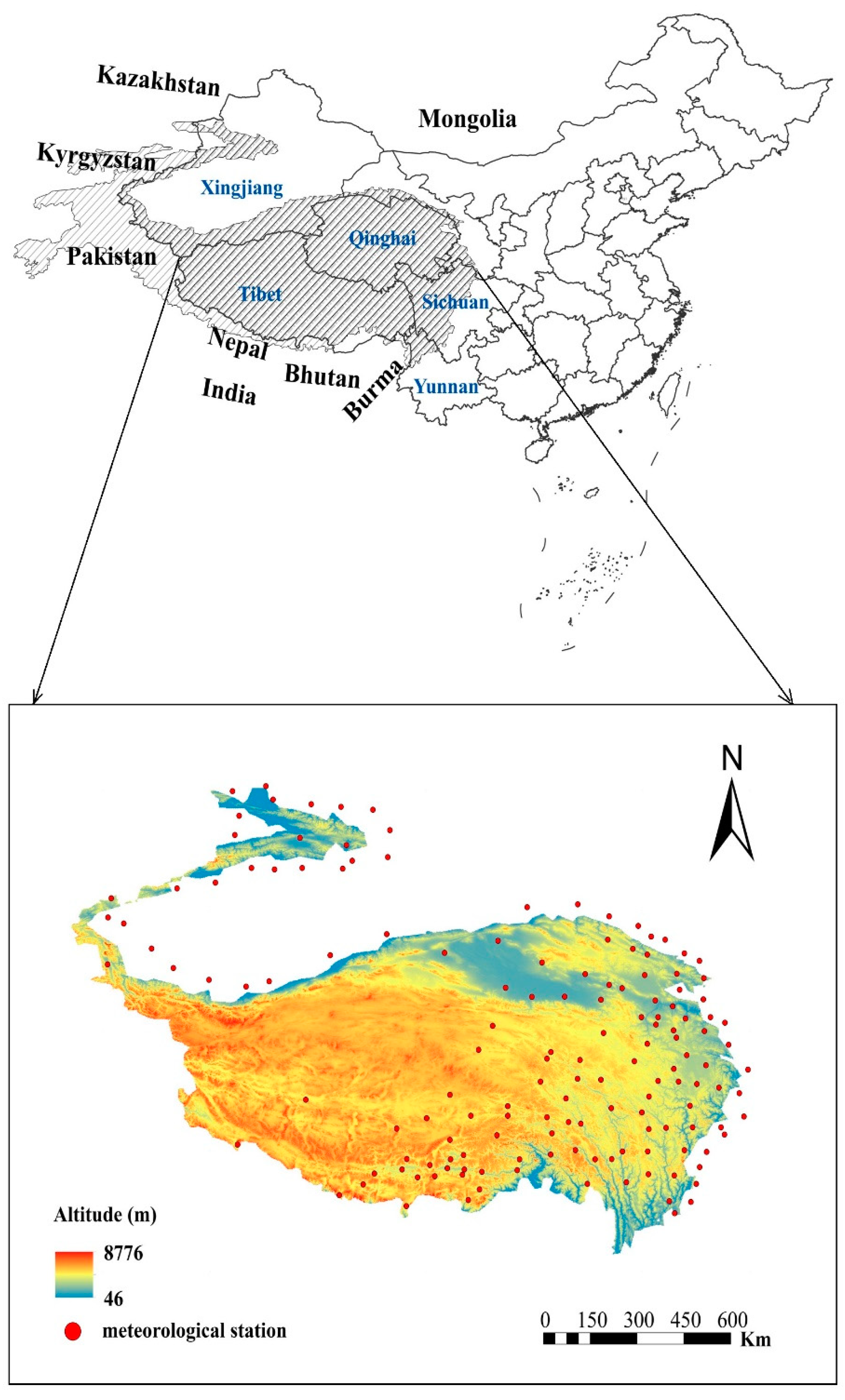
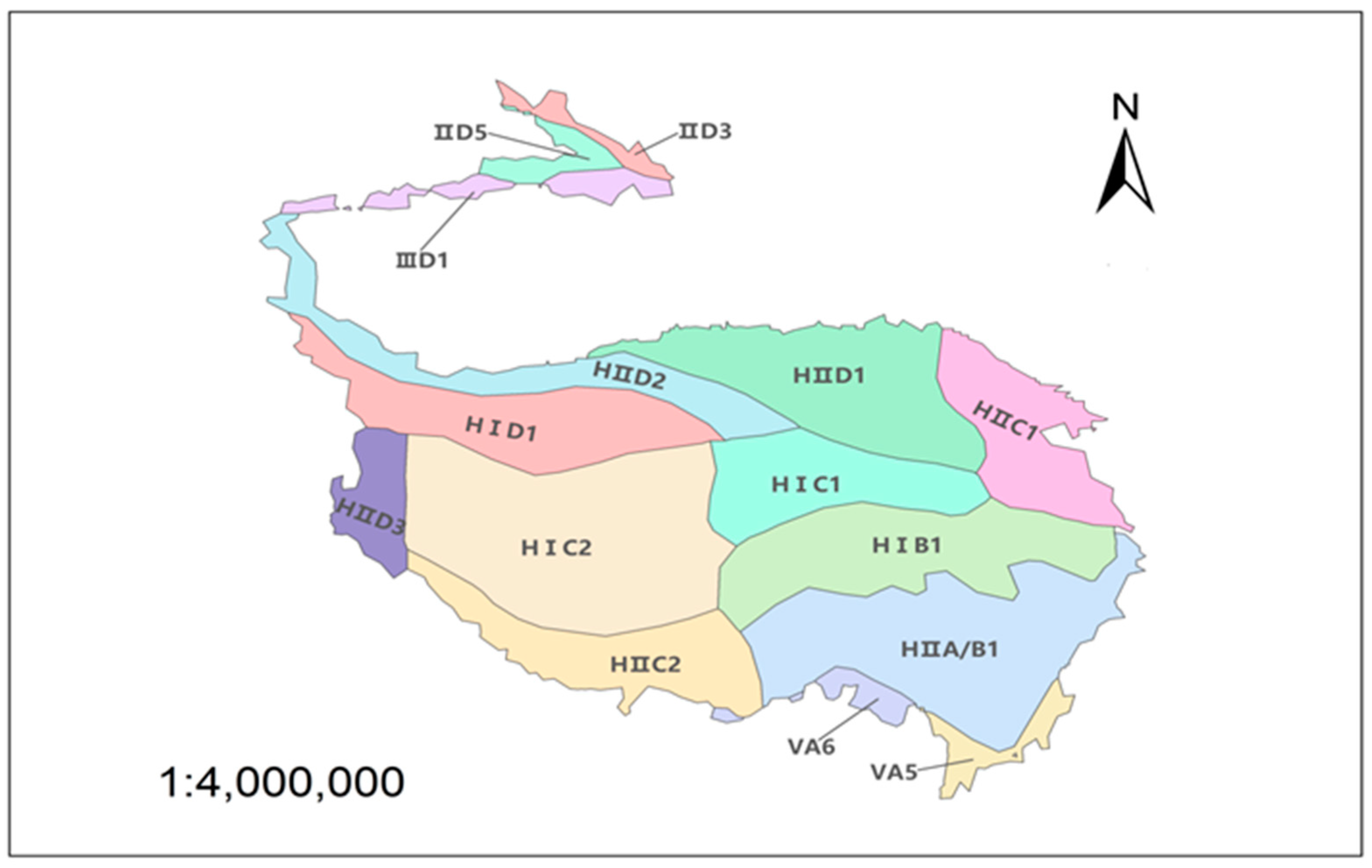
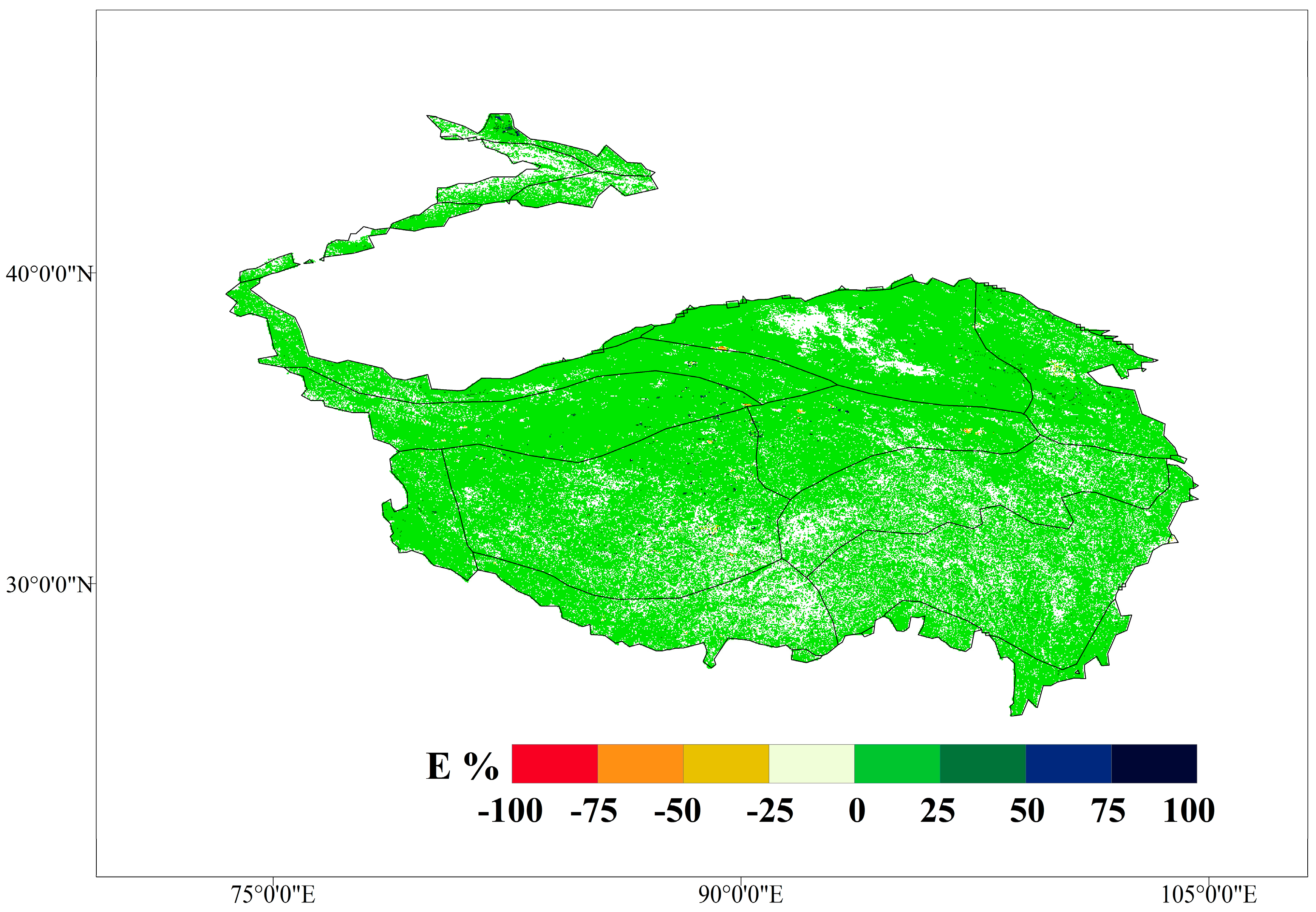
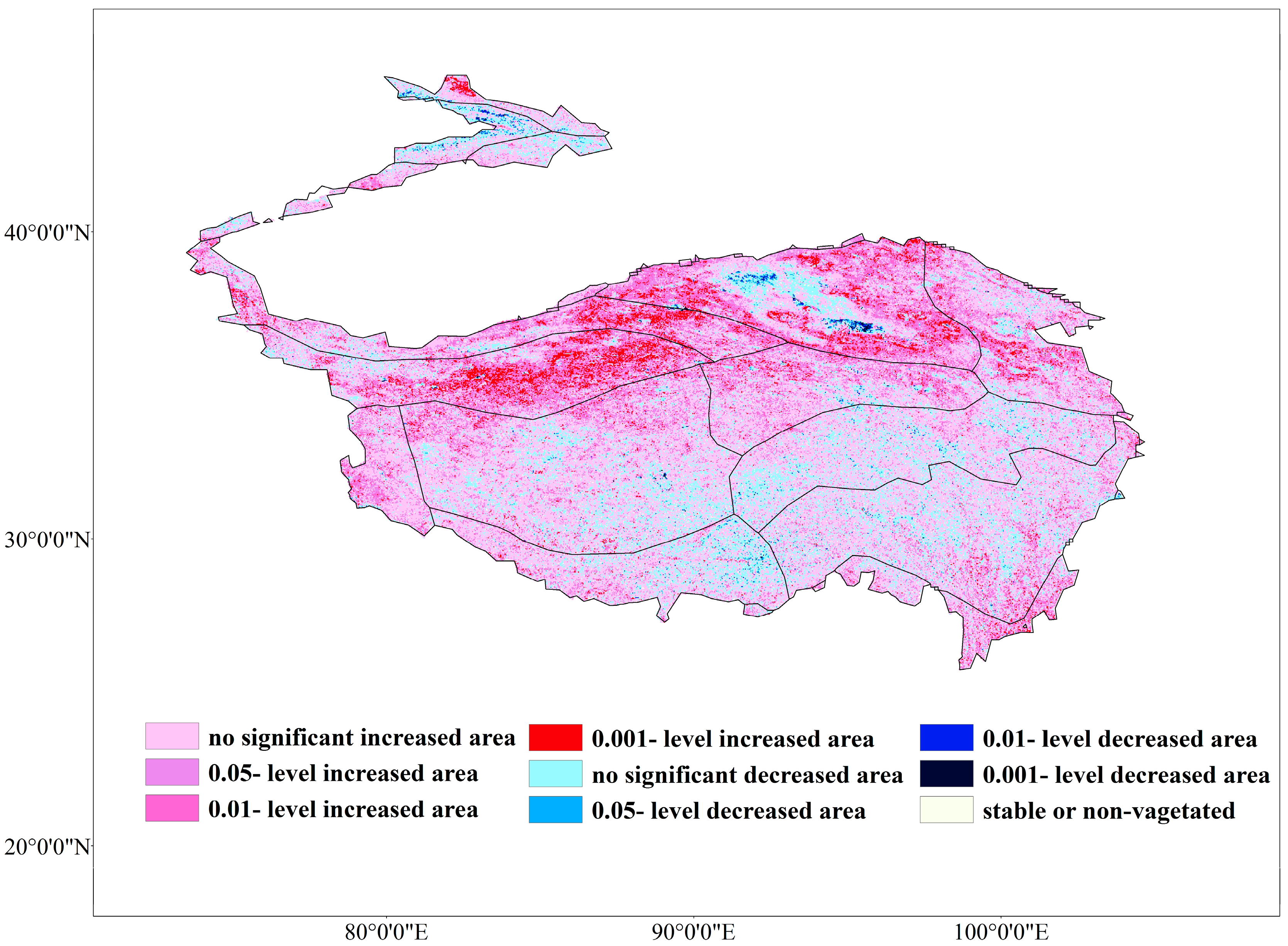
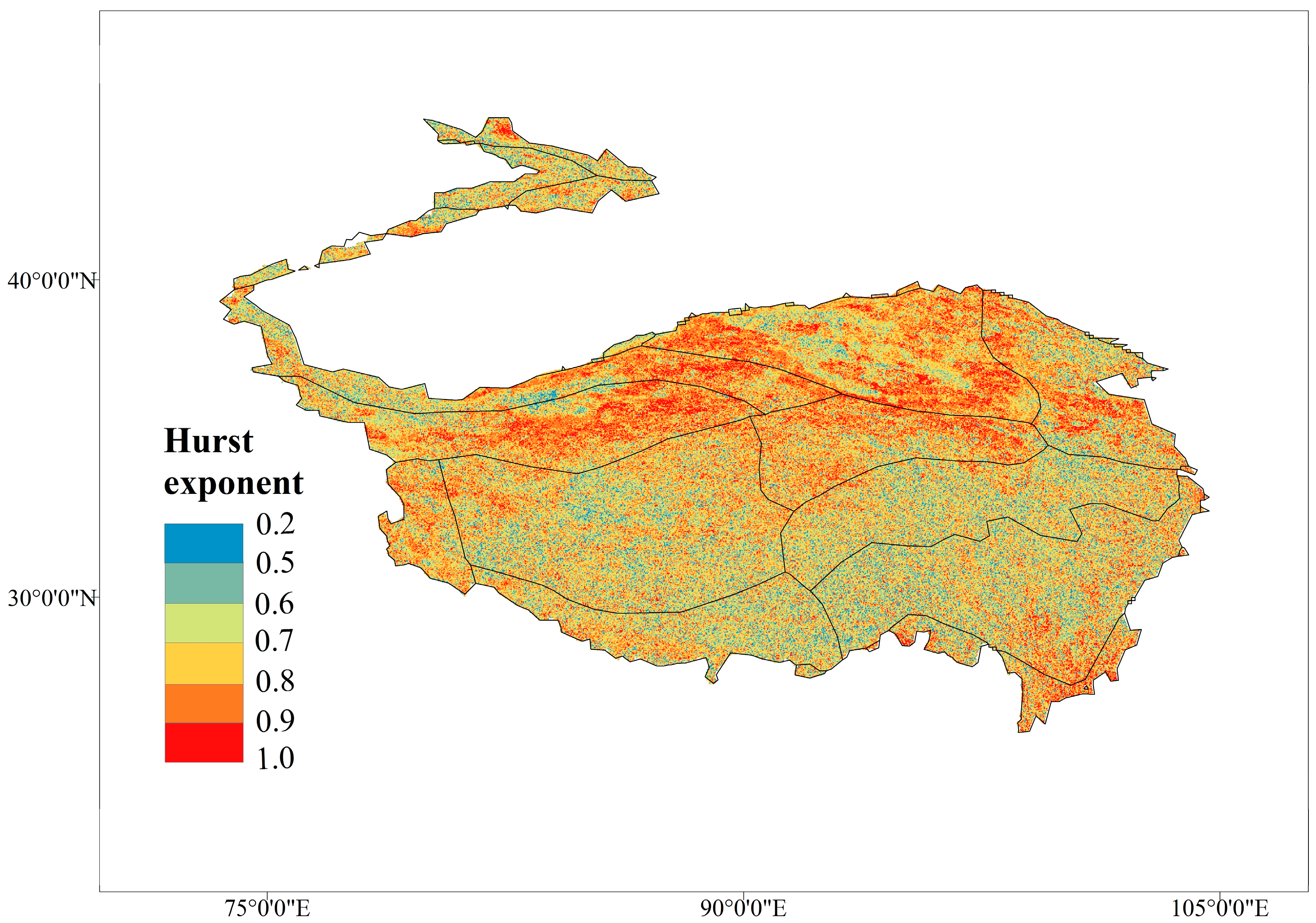
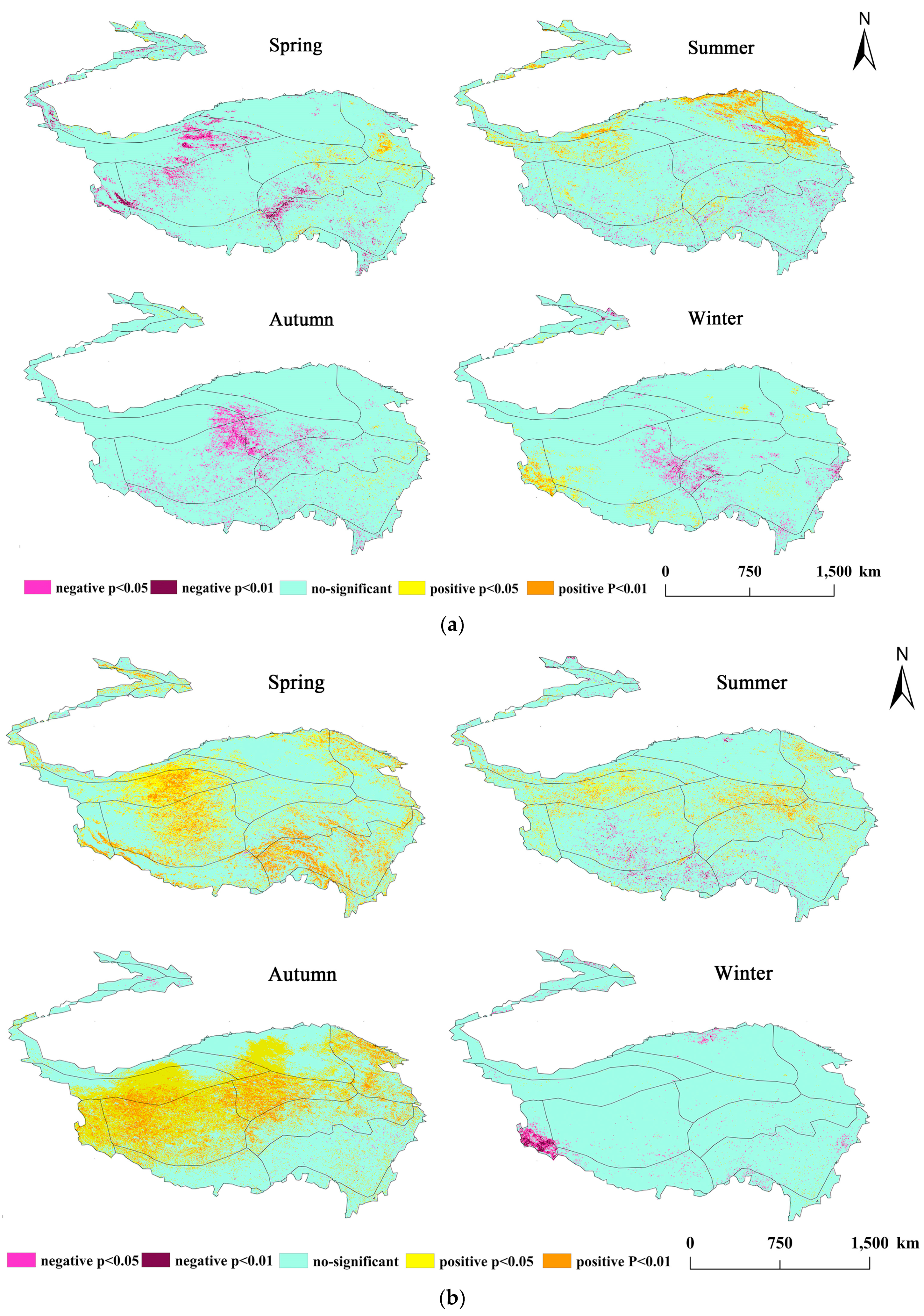
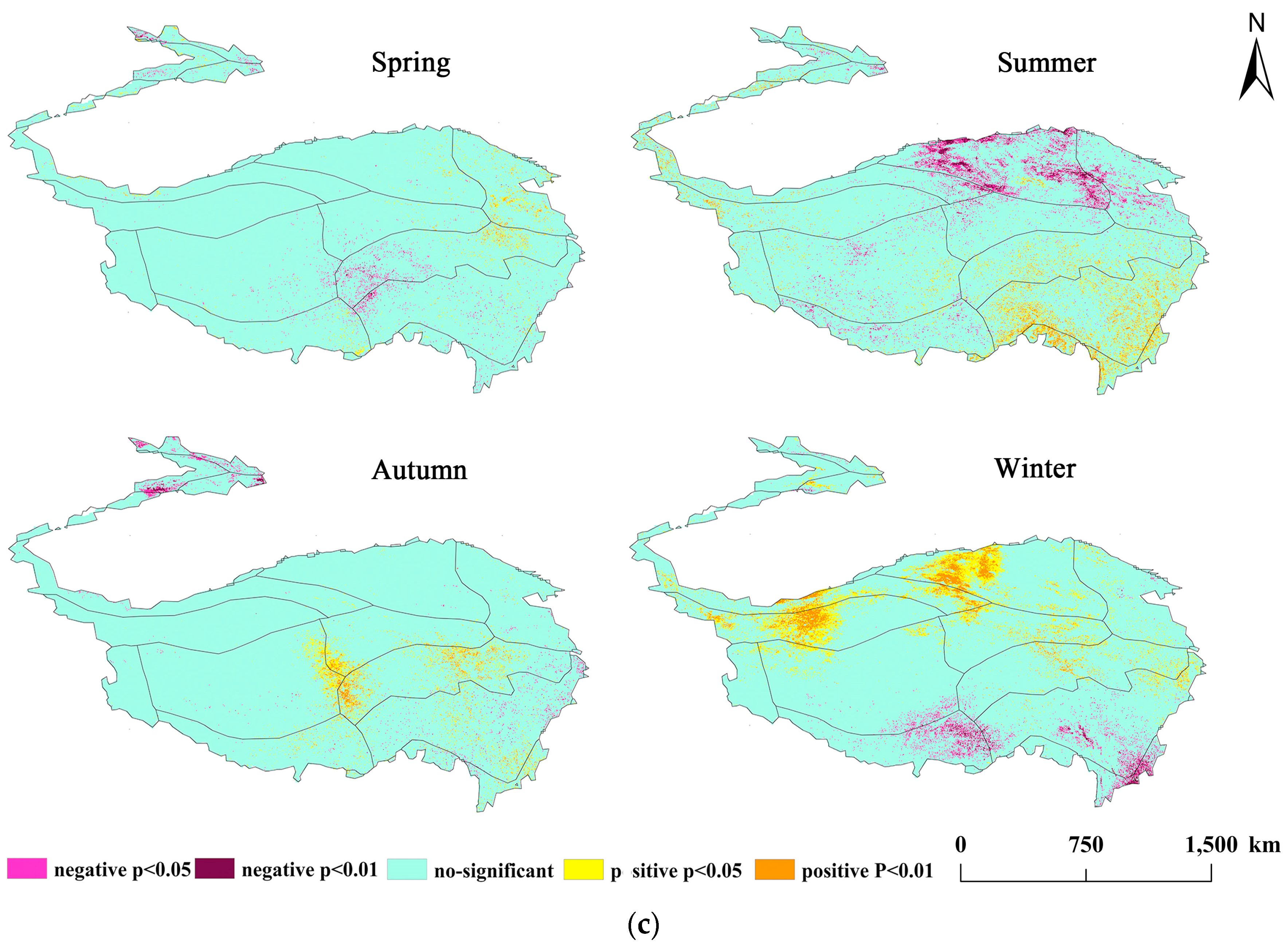

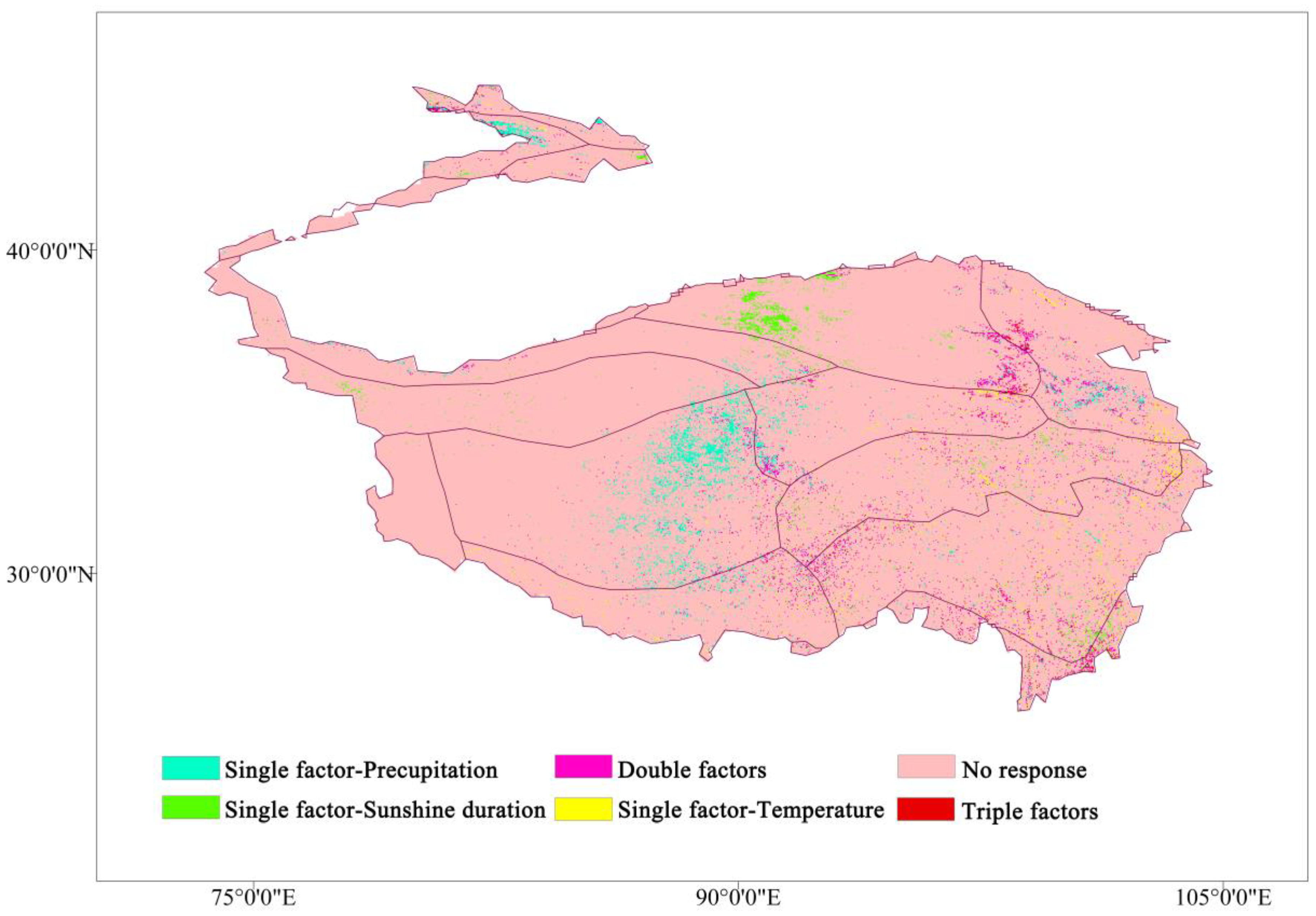
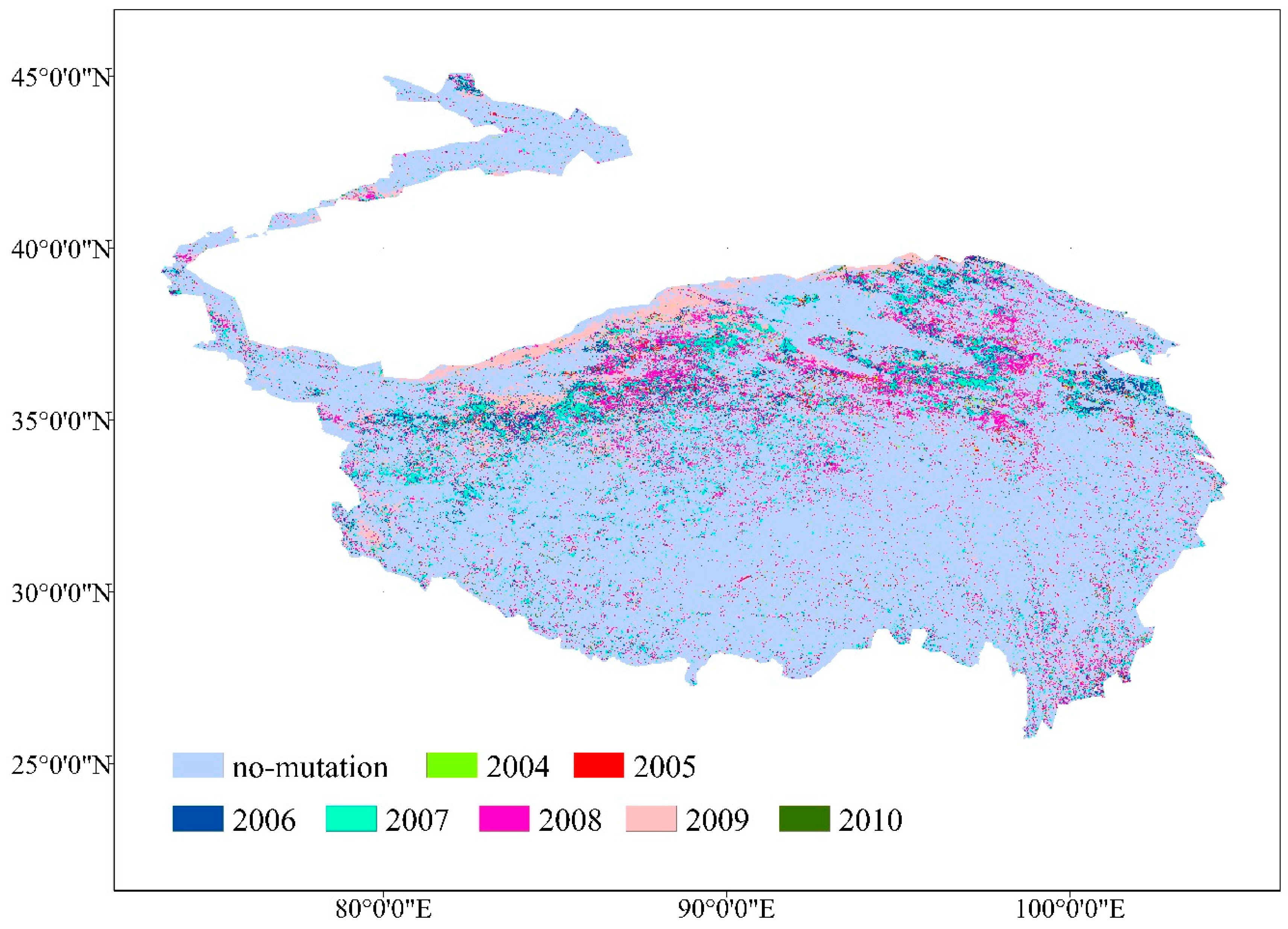
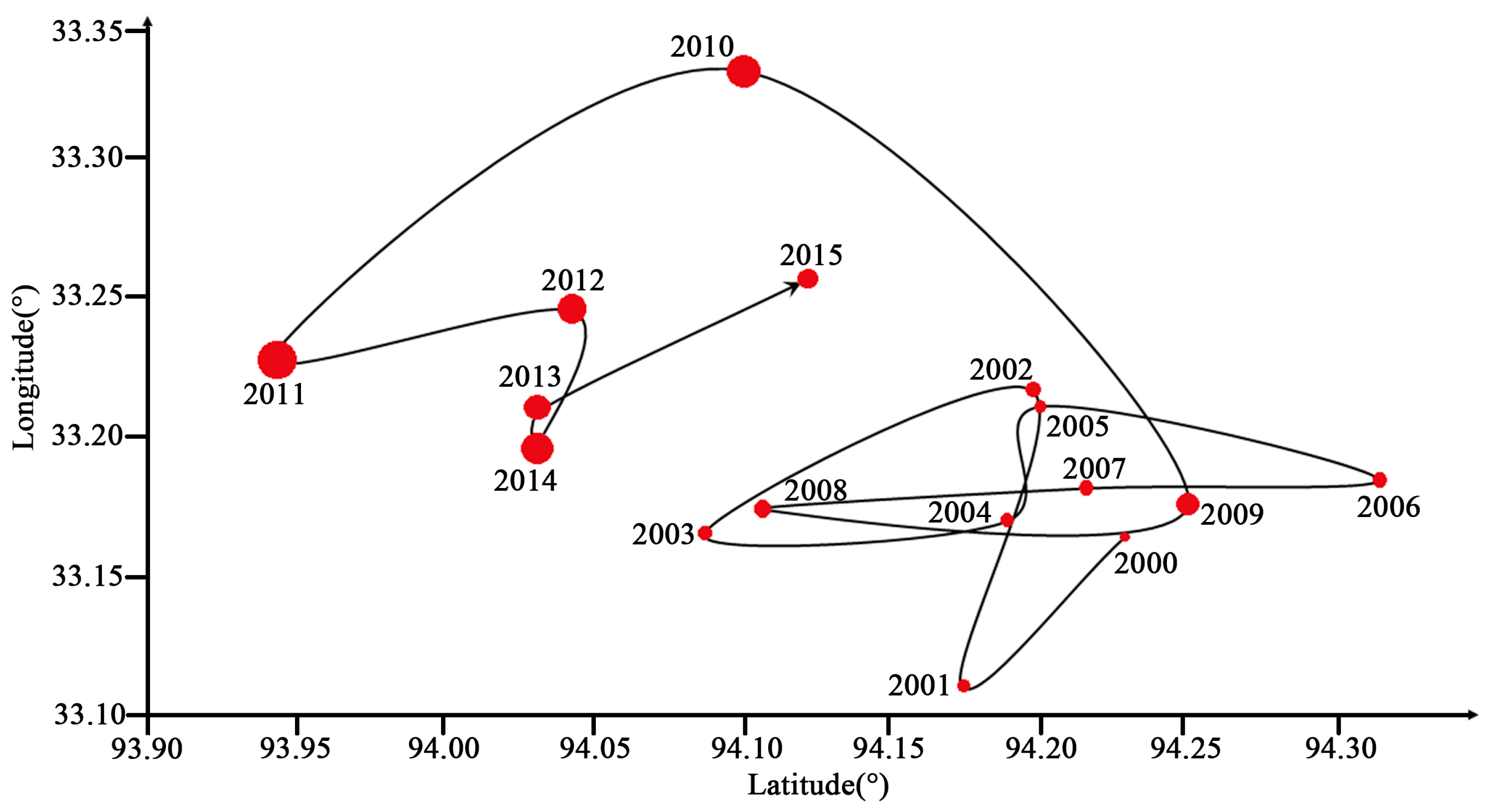

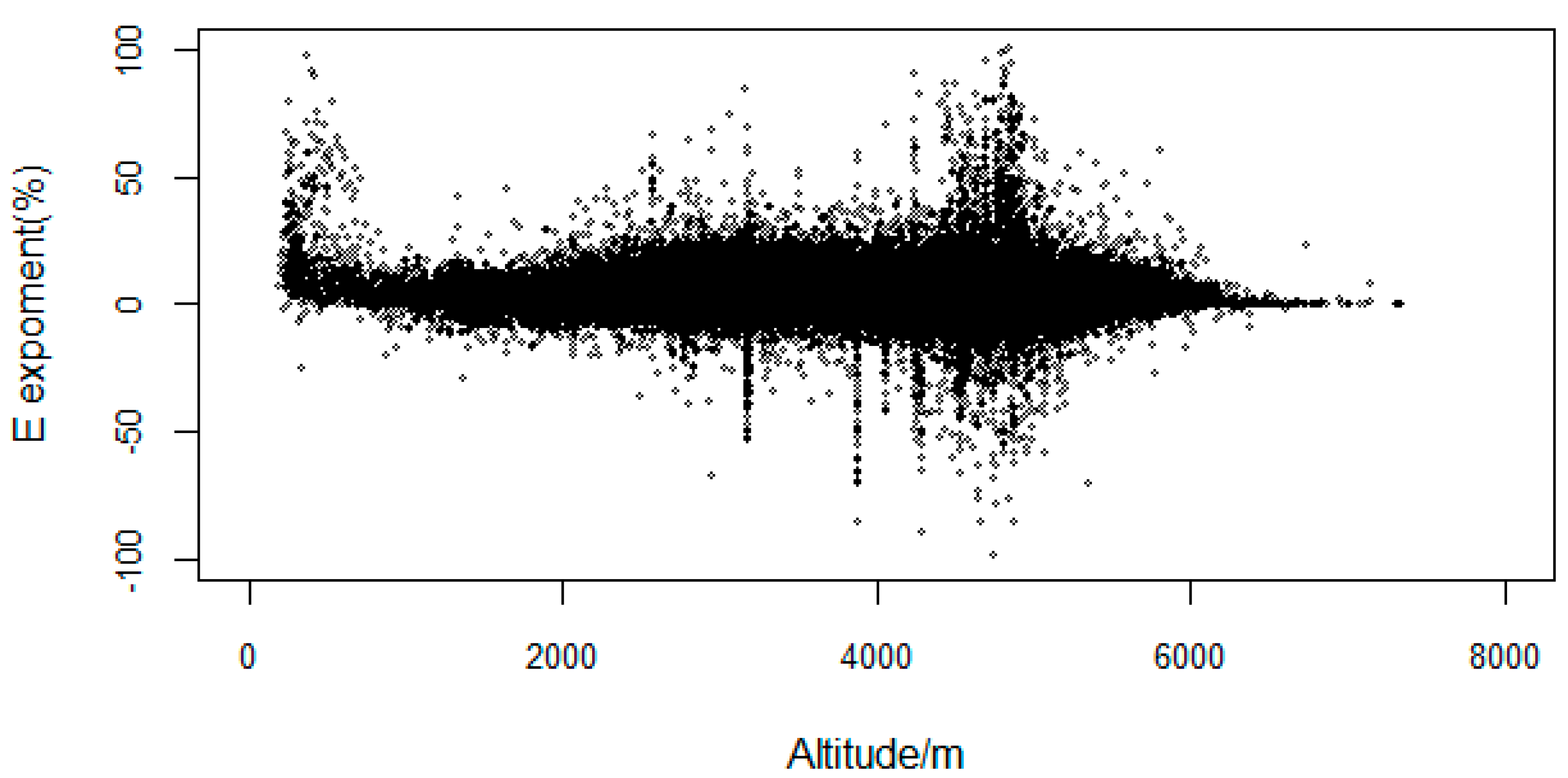

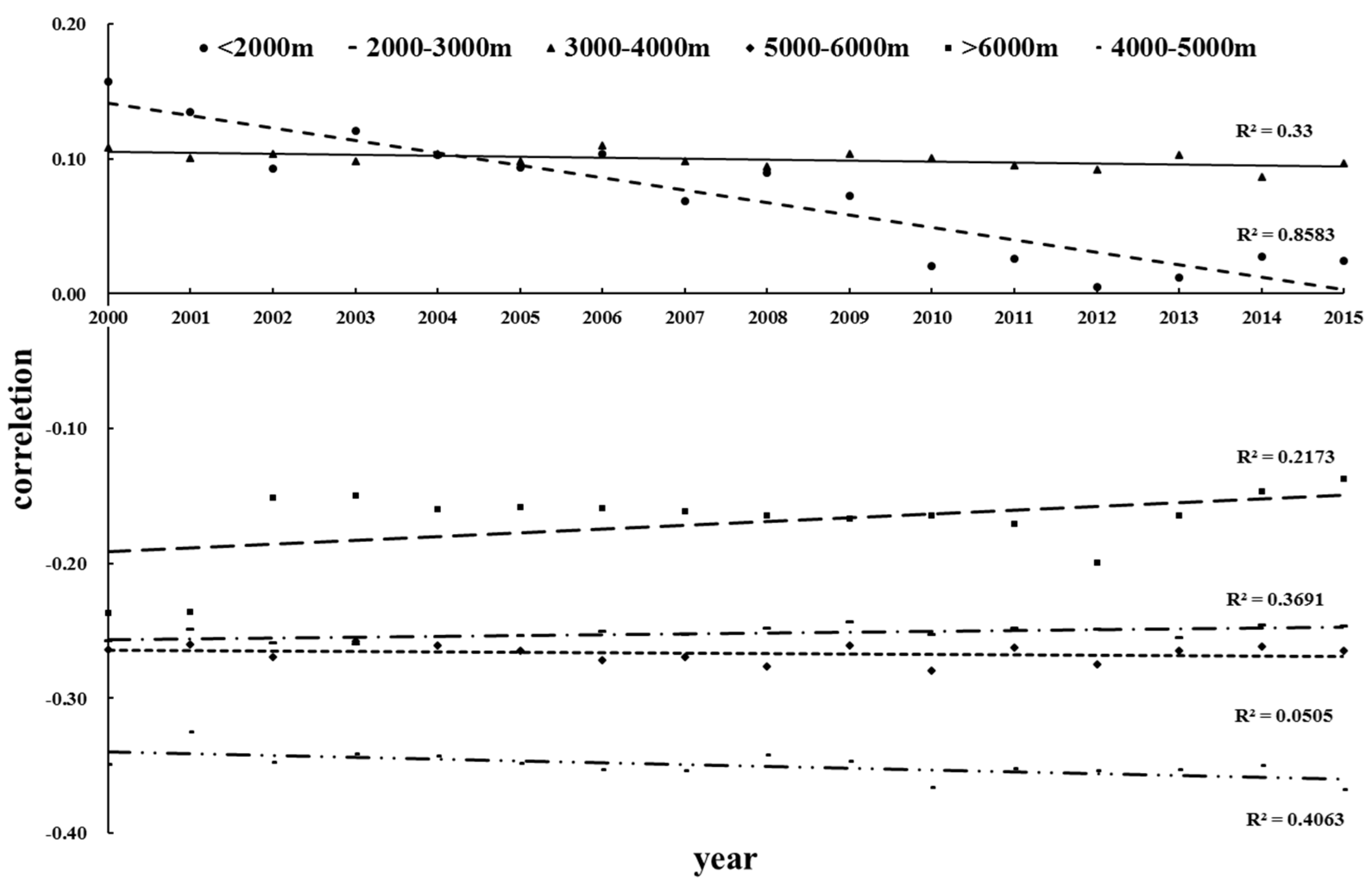
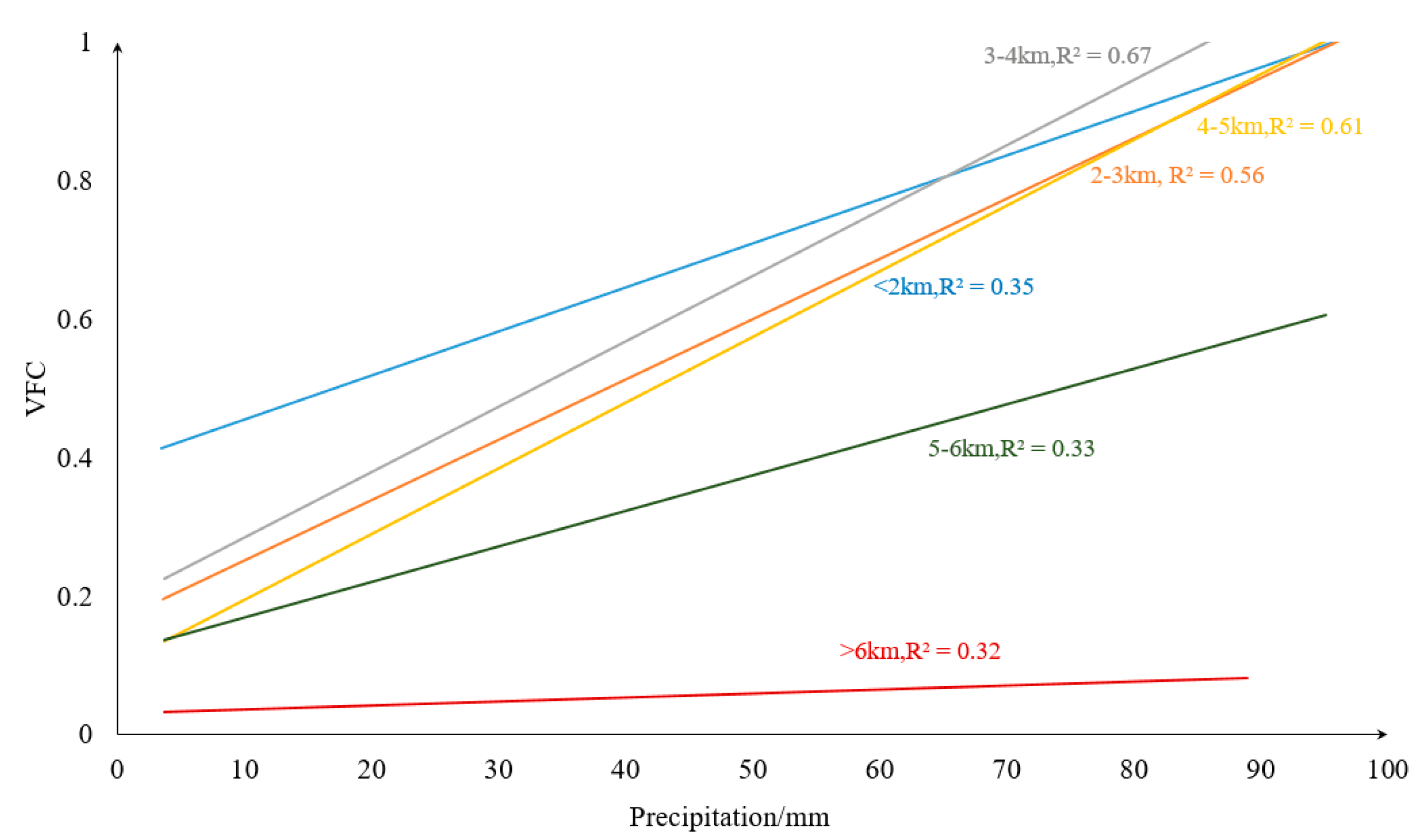
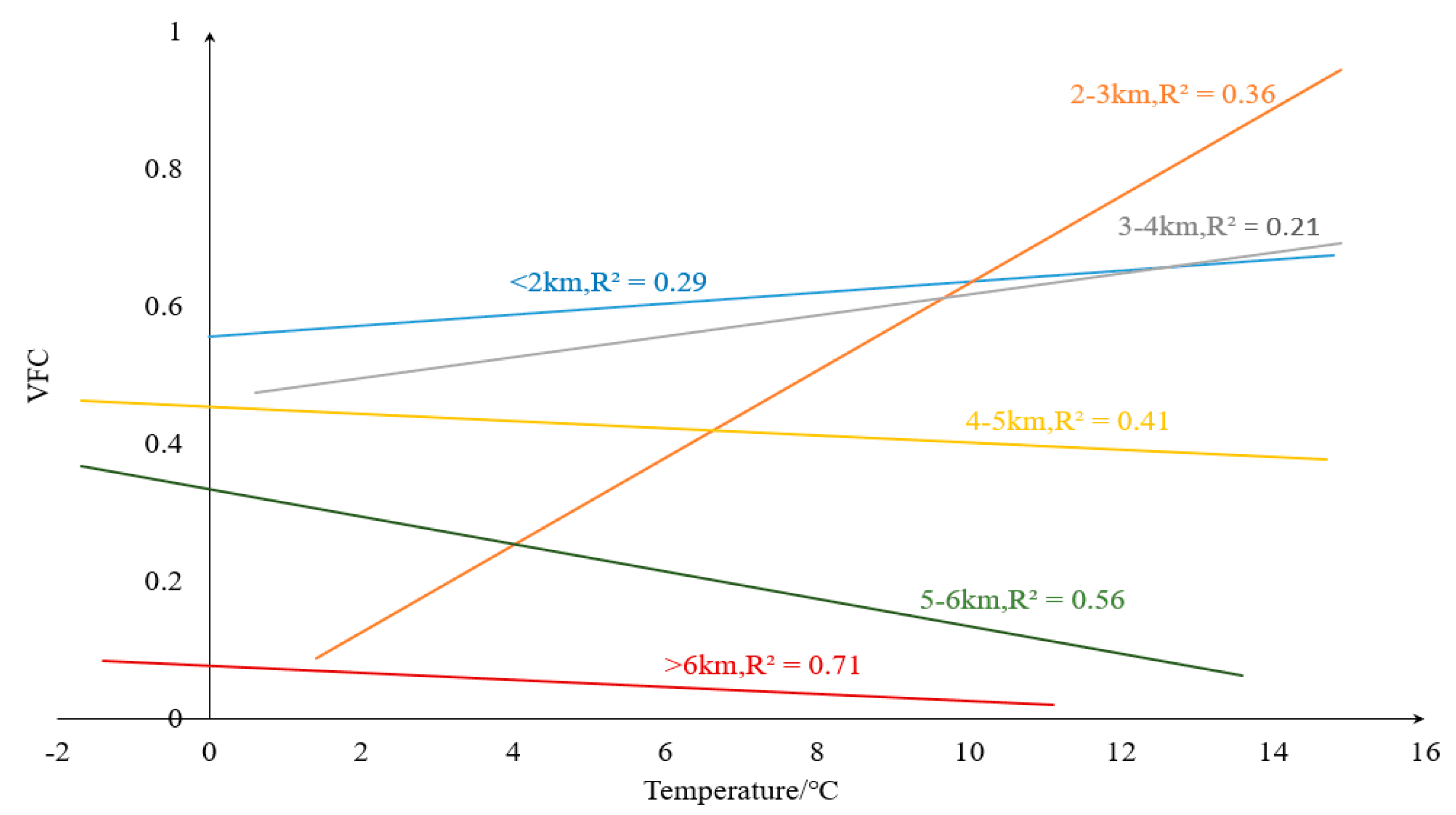
| Temperature Zone | Dry and Wet Area | Code | Eco-Geographical Division |
|---|---|---|---|
| HI | B | HIB1 | High-cold shrub meadow area in the Guoluahang Plateau |
| C | HIC1 | Tibetan Plateau wide valley alpine meadow steppe | |
| HIC2 | Quthai Lake Basin Alpine Grassland Area | ||
| D | HID1 | Kunlun high mountain plateau desert area | |
| HII | AB | HIIAB1 | Chuan Tibet eastern alpine valley coniferous forest |
| C | HIIC1 | Qingdong Qilian high mountain basin | |
| HIIC2 | Highland, Shrubland Steppe | ||
| D | HIID1 | Desert Area in Qaidam Basin | |
| HIID2 | Desert area in the north wing of the Kunlun Mountains | ||
| HIID3 | Ali mountain desert area | ||
| V | A | VA5 | Yunnan Plateau |
| VA6 | East Himalayan South Wing | ||
| II | C | IID5 | Yili Basin |
| IID3 | Junggar Basin | ||
| III | D | IIID1 | Tarim and Turpan Basin |
| Code | Area/km² | VFC | p | ||
|---|---|---|---|---|---|
| Mean | 2000 | 2015 | |||
| HID1 | 22.72 | 0.14 | 0.12 | 0.15 | 0.0007 (<0.001) |
| HIID1 | 29.77 | 0.17 | 0.15 | 0.19 | 0.0019 (<0.001) |
| HIID2 | 17.26 | 0.18 | 0.16 | 0.19 | 0.0018 (<0.001) |
| HIID3 | 7.34 | 0.21 | 0.20 | 0.23 | 0.0103 (<0.05) |
| HIC2 | 45.68 | 0.28 | 0.26 | 0.30 | 0.0016 (<0.01) |
| HIC1 | 17.9 | 0.38 | 0.36 | 0.38 | 0.0133 (<0.05) |
| IIID1 | 5.75 | 0.40 | 0.40 | 0.42 | 0.1373 (>0.05) |
| HIIC2 | 18.06 | 0.41 | 0.40 | 0.40 | 0.1151 (>0.05) |
| IID3 | 3.14 | 0.47 | 0.44 | 0.49 | 0.0274 (<0.05) |
| IID5 | 4.25 | 0.63 | 0.63 | 0.64 | 0.6204 (>0.05) |
| HIIC1 | 17.78 | 0.66 | 0.62 | 0.68 | 0.0004 (<0.001) |
| HIB1 | 27.30 | 0.69 | 0.68 | 0.69 | 0.2241 (>0.05) |
| HIIAB1 | 37.43 | 0.70 | 0.69 | 0.71 | 0.0217 (<0.05) |
| VA6 | 2.70 | 0.82 | 0.80 | 0.84 | 0.0001 (<0.001) |
| VA5 | 4.04 | 0.85 | 0.82 | 0.86 | 0.0003 (<0.001) |
| Significant Degree | The Degree of Vegetation Change | The Percentage of Total Area (%) | Area (km2) |
|---|---|---|---|
| p < 0.05 | Slightly improvement | 13.89 | 362,529 |
| p < 0.01 | Moderate improvement | 10.71 | 2,610,000 |
| p < 0.001 | Severe improvement | 4.18 | 109,098 |
| p < 0.05 | Stable | 1.80 | 46,980 |
| p < 0.05 | Slightly degradation | 0.07 | 1827 |
| p < 0.01 | Moderate degradation | 0.30 | 7830 |
| p < 0.001 | Severe degradation | 0.09 | 2349 |
| p > 0.05 | No significant | 68.23 | 1,780,803 |
| Climatic Factors | Correlation (p < 0.05) | Spring | Summer | Autumn | Winter | |
|---|---|---|---|---|---|---|
| Precipitation | positive | Area ratio (%) | 2.79 | 10.48 | 0.74 | 2.83 |
| Concentrated eco-geographical division | HIB1/HIIC1/HIC1 | HIIC1/HIID1/HID1 | HIIA/B1 | HIID3/HIIC2 | ||
| negative | Area ratio (%) | 4.72 | 1.98 | 4.17 | 2.12 | |
| Concentrated eco-geographical division | HIID3/HIC2/HID1/HIB1/HIIA/B1 | Less and discrete | HIC2/HIC1/HIB1 | HIC2/HIB1 | ||
| Temperature | positive | Area ratio (%) | 27.42 | 10.32 | 39.21 | 0.31 |
| Concentrated eco-geographical division | HID1/HIC2/HIB1/HIIA/B1/HIIC1 | HID1/HIC1/HIIC1/HIB1 | HIID3/HIC2/HID1/HIC1/HIIC1 | Less and discrete | ||
| negative | Area ratio (%) | 0.18 | 3.80 | 0.17 | 1.79 | |
| Concentrated eco-geographical division | Less and discrete | HIC2/HIIC2 | Less and discrete | HIID3 | ||
| Sunshine duration | positive | Area ratio (%) | 1.70 | 6.78 | 1.91 | 10.30 |
| Concentrated eco-geographical division | HIIC1/HIB1 | HIB1/HIIA/B1/VA5/VA6 | HIB1 | HID1/HID1/HIID2 | ||
| negative | Area ratio (%) | 0.93 | 4.36 | 0.72 | 2.21 | |
| Concentrated eco-geographical division | HIB1/HIIA/B1 | HIID1/HIIC1 | IID3/IID5 | HIIC2/HIIA/B1/VA5 | ||
© 2019 by the authors. Licensee MDPI, Basel, Switzerland. This article is an open access article distributed under the terms and conditions of the Creative Commons Attribution (CC BY) license (http://creativecommons.org/licenses/by/4.0/).
Share and Cite
Zhang, Y.; Xu, G.; Li, P.; Li, Z.; Wang, Y.; Wang, B.; Jia, L.; Cheng, Y.; Zhang, J.; Zhuang, S.; et al. Vegetation Change and Its Relationship with Climate Factors and Elevation on the Tibetan Plateau. Int. J. Environ. Res. Public Health 2019, 16, 4709. https://doi.org/10.3390/ijerph16234709
Zhang Y, Xu G, Li P, Li Z, Wang Y, Wang B, Jia L, Cheng Y, Zhang J, Zhuang S, et al. Vegetation Change and Its Relationship with Climate Factors and Elevation on the Tibetan Plateau. International Journal of Environmental Research and Public Health. 2019; 16(23):4709. https://doi.org/10.3390/ijerph16234709
Chicago/Turabian StyleZhang, Yixin, Guoce Xu, Peng Li, Zhanbin Li, Yun Wang, Bin Wang, Lu Jia, Yuting Cheng, Jiaxin Zhang, Shaohao Zhuang, and et al. 2019. "Vegetation Change and Its Relationship with Climate Factors and Elevation on the Tibetan Plateau" International Journal of Environmental Research and Public Health 16, no. 23: 4709. https://doi.org/10.3390/ijerph16234709
APA StyleZhang, Y., Xu, G., Li, P., Li, Z., Wang, Y., Wang, B., Jia, L., Cheng, Y., Zhang, J., Zhuang, S., & Chen, Y. (2019). Vegetation Change and Its Relationship with Climate Factors and Elevation on the Tibetan Plateau. International Journal of Environmental Research and Public Health, 16(23), 4709. https://doi.org/10.3390/ijerph16234709





